Meet Elmwood Cemetery’s Captivating Cast of Characters
Millionaires, outlaws and heroines populate the most storied cemetery in Memphis.
Millionaires, outlaws and heroines populate the most storied cemetery in Memphis.
For 23 years, Kim Bearden has walked the paths of Elmwood Cemetery. Beneath the its haughty branches, she’s gathered the stories of Memphis history, legends whispered in coffee shops and bars not far from the wrought iron gates of the graveyard—legends that come to life inside.
“I spent time in cemeteries as a young person,” says Bearden, Elmwood’s executive director. “It had always been for funerals, though. The occasions were always sad. So coming to work at Elmwood and delving into history to learn these stories was a magical experience for me. That’s when I began to fall in love with this place.”

Those stories include celebrities, politicians, generals, paupers and spies. Their cast of characters runs the gamut from city founders to saloon owners, from outlaws to heroes. And while nearly 80,000 Memphians rest beneath the soil of this 80-acre wood, Bearden has her favorites, some of which she shared with I Love Memphis on a twilight visit to the city’s most historic refuge for the dead.
Robert Church
Robert Church was the first Black millionaire in the South. Memphis would not exist as it is today without his remarkable contributions.
Church was born an enslaved person in 1839 and escaped to freedom during the Civil War. Working odd jobs around Memphis, Church saved up enough money to purchase a saloon on Beale Street. During the 1866 Memphis Massacre, he was shot and left for dead inside of his own bar, but miraculously survived. He became a real estate tycoon and a banker who loaned money to Black citizens to purchase their own land.
Church famously operated a 2,200-seat auditorium near the present-day FedExForum called Church Park. At the time, it was the only Black-owned auditorium of its kind in the country. The venue welcomed dignitaries like Theodore Roosevelt and Booker T. Washington, and even employed “The Father of the Blues” W.C. Handy as its orchestra leader.
During 1878’s devastating yellow fever epidemic, thousands of Memphians evacuated the city, leaving streets, homes, and businesses abandoned. Memphis lost its official city charter, but Church stepped up to save the city. He purchased bonds and invested in property, helping to restore the population and the city’s standing. His imposing mausoleum stands in the southwest portion of Elmwood.

Enslaved Africans
It’s impossible to tell the story of Memphis without acknowledging its tragic connection to the transatlantic slave trade. At the onset of the Civil War, about 3,000 enslaved people lived in Memphis, an integral part of the city’s economic foundation: the cotton industry and trade along the Mississippi River. This monument near Church’s mausoleum pays homage to more than 300 unnamed enslaved people who were buried in Elmwood between 1852 and the end of the war in 1865.

Emily Sutton
Genteel society was sent into an uproar when the tomb of Emily Sutton was erected among the city’s elite in 1875. To them, Sutton was known by another alias—Fannie Walker. As Walker, Sutton ran a brothel that she converted into a hospital during the 1873 yellow fever epidemic, an epidemic that took her life.
Sutton was mysteriously moved to a desirable location in Elmwood two years later by a benefactor lost to time, though rumors still whisper that it could have been wealthy Memphis socialite Ed Worsham. Worsham was the lone recipient of Sutton’s will and is buried nearby.
Lide Smith Meriwether
A hero of early women’s suffrage, Lide Smith Meriwether founded a pro-women’s rights newspaper in 1871 called The Tablet. She also published Soundings, an 1872 book condemning hypocrisy and a double standard of sexuality in society. Meriwether advocated for the rights of female sex workers, lobbied for prohibition, founded a city women’s shelter, served as president of the Tennessee Women’s Christian Temperance Union and created the first Equal Rights Association in Memphis.
Marion Scudder Griffin
Another groundbreaking woman rests not far from Meriwether. Marion Scudder Griffin rose from humble beginnings as a Georgia stenographer to become the first woman elected to the state house of representatives and the first woman lawyer in Tennessee. This was no small feat in the early 20th century. Griffin was twice denied certification to the state bar on the basis of her sex, and ultimately pushed state lawmakers to pass new legislation allowing women to practice law in 1907.
She became an advocate for the social welfare of women and children during her time in the state legislature before retiring in 1949.
Chinese Americans
A prominent hill in the cemetery’s south-central section harbors the graves of more than 250 Chinese Americans dating back to the early 1880s. In fact, many immigrants from around the world are buried within Elmwood Cemetery. Chinese isn’t the only international language found on tombs here. Elsewhere, visitors can spot inscriptions in Arabic, German, Greek, Korean and Spanish.
Donoho Mausoleum
As much as we do know about Elmwood’s residents, there are also many secrets and tales lost to time. The mysterious builders of the Donoho Mausoleum have long since vanished into history. According to Bearden, little information remains about the family or the mausoleum’s inspiration. Its haunting, gothic architecture is shaped like a cross and coated in horse hair plaster. The mausoleum is one of nine such structures within Elmwood, and the staff conducts occasional mausoleum tours for those curious about their origins.
Kit Dalton
A lone monument rises above a field of flat, nondescript stone markers in the Soldier’s Rest section of Elmwood. It marks the final resting place of Kit Dalton, a former Confederate guerrilla fighter that rose to infamy while riding with Western outlaws Frank and Jesse James. Dalton once carried a $50,000 bounty: dead or alive. However, Dalton was able to broker a deal with the courts for his freedom in the early 1880s.
He lived the rest of his days in Memphis until passing away in 1920. He was buried among more than 1,000 other Confederate soldiers. Originally, Union veterans were also buried in Solider’s Rest but they were moved to Memphis National Cemetery—far from their foes—in 1868.
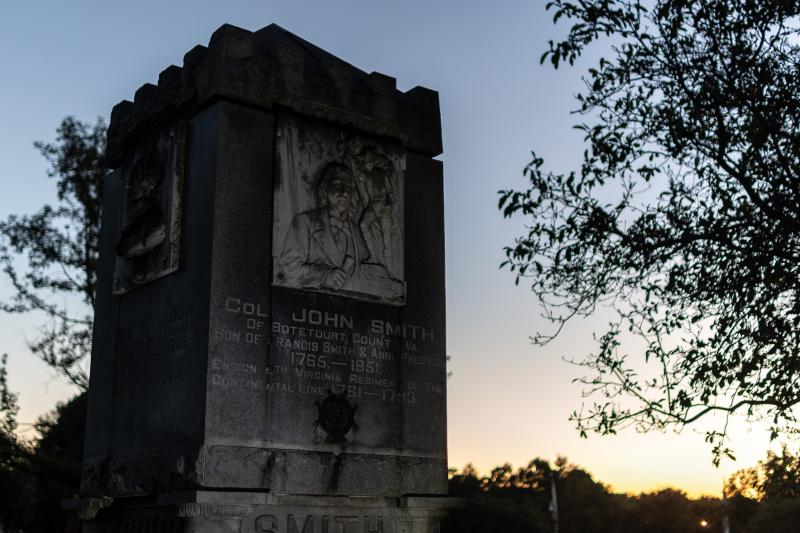
Colonel John Smith
Colonel John Smith holds the distinction of being the only veteran of the American Revolution buried at Elmwood, a curious circumstance born out of marriage into the prominent Winchester family. The continental soldier from Virginia was buried in his home state during 1851, before being disinterred twice and arriving at Elmwood two decades later. However, Smith isn’t the only American soldier buried at Elmwood. Fourteen soldiers from the War of 1812 reside there, along with veterans from the Civil War, World Wars, Korea and Vietnam.
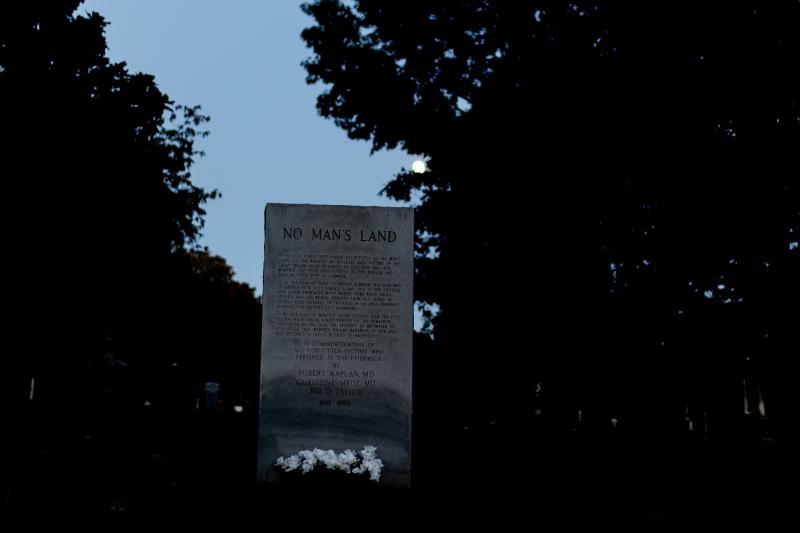
No Man’s Land
The summer of 1878 was cataclysmic for Memphis. Though the city had battled yellow fever in the past, the wave that struck during the waning months of that summer was the worst ever seen. The city’s church bells tolled incessantly with funerals. More than half of the city’s population fled, while nearly 80 percent of those remaining contracted the disease.
That summer, some 5,100 Memphians died within a three month span, turning schools into hospitals and many buildings into makeshift morgues. At the height of the epidemic, Elmwood was handling 50 burials per day.
7,500 of the dead still rest in the cemetery—1,000 of them in unmarked trenches now known as No Man’s Land.
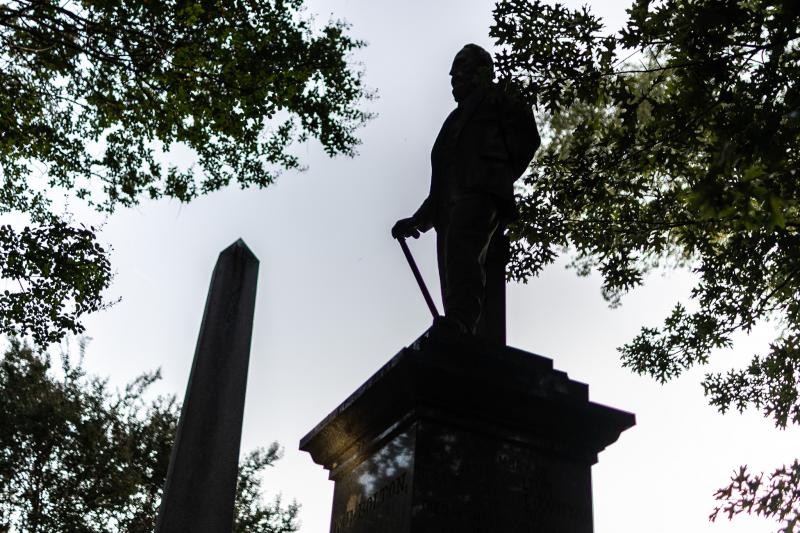
Wade Bolton
Wade Bolton was gunned down in a family feud in downtown’s Court Square in 1869. The founder of what became Bolton High School rests beneath a replica of himself in what appears to be a dapper, three-piece suit. Upon closer inspection, though, it’s clear that Bolton’s left shoe is untied and his vest is mis-buttoned.
Bolton was not the only casualty of this family feud. At least eight people were killed in the fight, which centered around a slave trade dispute prior to the Civil War. Bolton’s killer was gunned down months later.
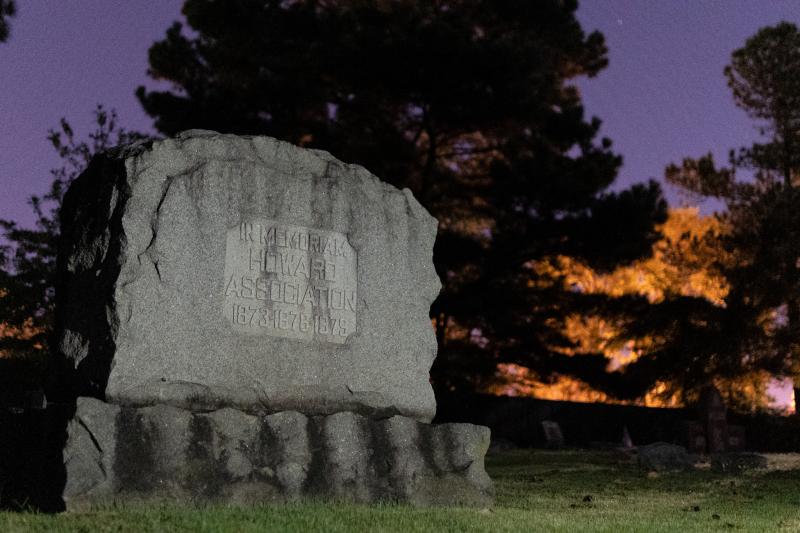
The Howard Association
Groups of cigar-puffing* doctors once patrolled Memphis in response to the city’s repeated battles with yellow fever. In 1873, 1878 and 1879, these heroic healthcare workers emerged with yellow armbands to deliver medicine and food to the sick. They also collected money and organized aid to the miserable masses of Memphians afflicted by the lethal, mosquito-borne illness. During the most vicious pandemic, the Howard Association raised an incredible $500,000 and oversaw an army of nearly 3,000 nurses at the cost of nearly a third of their own membership to the disease.
*People used cigar smoke as a mosquito repellant for their own comfort. Coincidentally, scientists would discover that mosquitos spread yellow fever until decades after these epidemics.
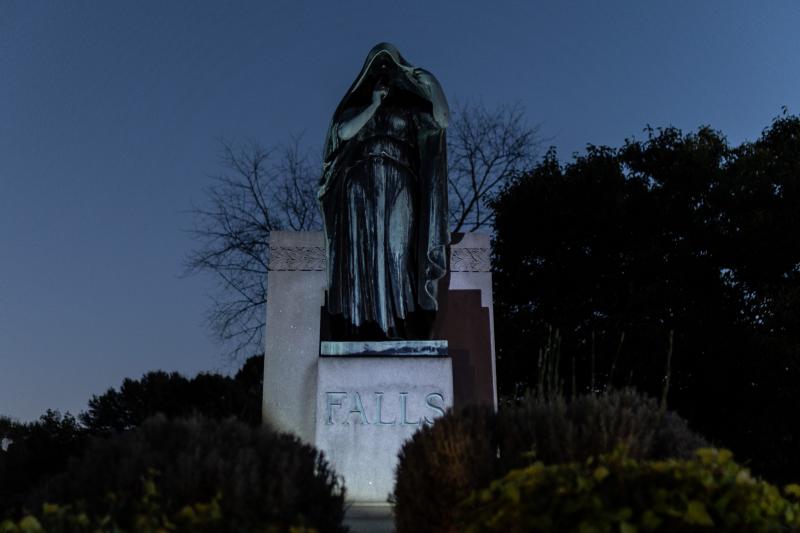
Falls Monument
Bearden’s favorite sculpture is the enigmatic Falls Monument. The beautifully crafted visage of a cloaked woman is the only life-size figure within Elmwood without wings. “I think she’s a woman in mourning,” says Bearden. “She’s got a finger over her lips, as if she’s telling us to be quiet or to stop and listen, to appreciate the dead.” As night begins to shroud Elmwood in darkness, the Falls Monument casts a poignant portrait over those at eternal rest.
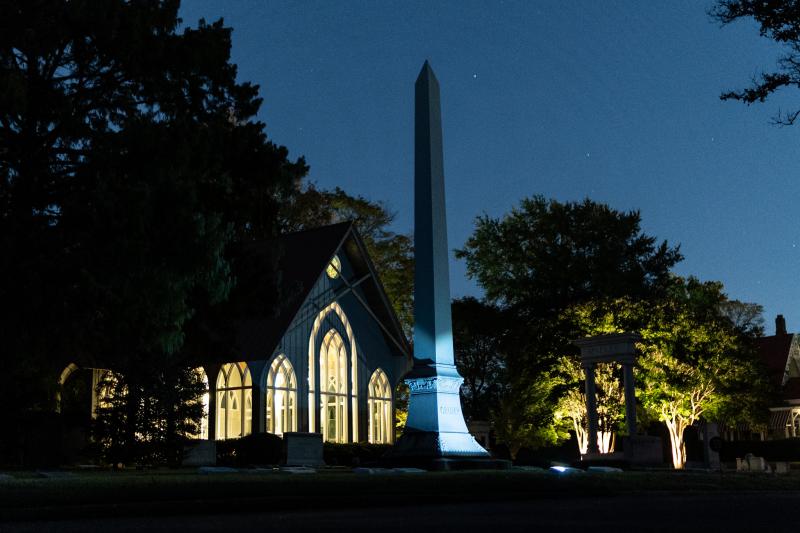
E.H. Crump
The towering obelisk of former Memphis mayor E.H. “Boss” Crump stands sentinel over Elmwood’s entrance. Crump’s glimmering grave is as the “Boss” himself was in life: impossible to ignore. For much of the early 20th century, a political machine helmed by Crump leveraged poll taxes and Black voters to exert pressure on state and even federal governments. Crump’s legacy is as complex as the machine helped create.
Crump is credited with bringing employment opportunities to Memphis, especially under Franklin Roosevelt’s New Deal. His administration and proxy administrations improved public services within the city and kept taxes low. However, Crump also received kickbacks from the city’s criminal underworld, ran insurance scams on local business owners, and sought to intimidate labor organizations and the city’s Black leadership.
Crump also oversaw the egregious demolition of Robert Church’s 14-room downtown Memphis estate, in which he ordered the fire department to burn the Queen Anne mansion as a demonstration of their new fire engines. Later, the Church estate was used as a location for Foote Homes, a public housing project demolished in 2016.
VISIT ELMWOOD CEMETERY
Elmwood Cemetery, located at 824 S. Dudley Streeat, is open Monday through Saturday from 8 a.m. to 4:30 p.m. Regular tours, including twilight tours, are available throughout the year. Peak season runs from March-November, and the cemetery is still an active burial ground today. The cemetery also hosts periodic movie screenings. Check their Facebook page for more events and activities.




Comments Make Us Happy